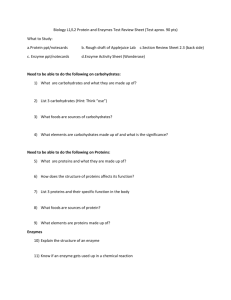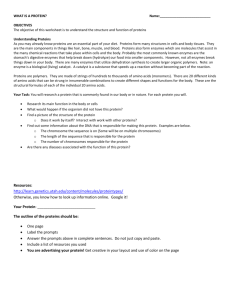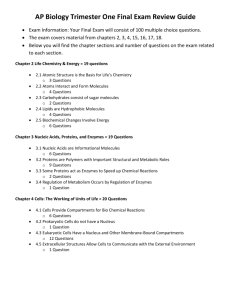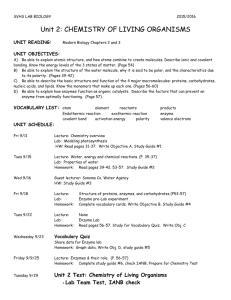Time-table of practical classes on biochemistry for students of
advertisement
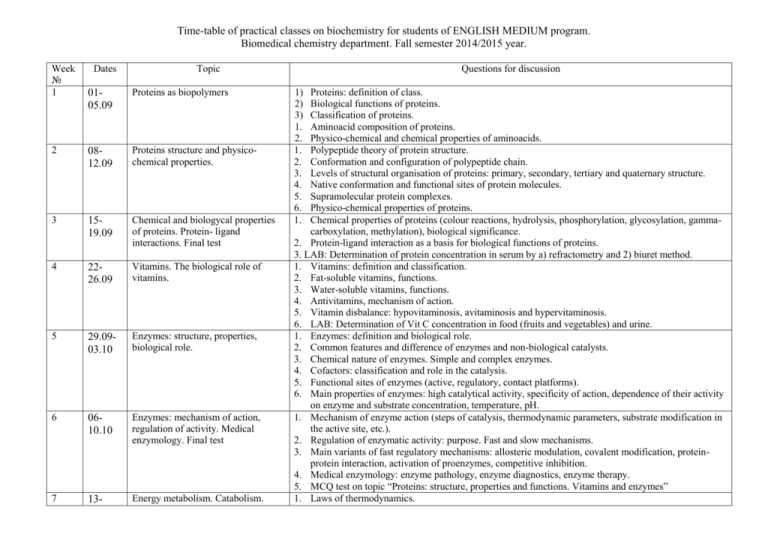
Time-table of practical classes on biochemistry for students of ENGLISH MEDIUM program. Biomedical chemistry department. Fall semester 2014/2015 year. Week № 1 Dates Topic 0105.09 Proteins as biopolymers 2 0812.09 Proteins structure and physicochemical properties. 3 1519.09 Chemical and biologycal properties of proteins. Protein- ligand interactions. Final test 4 2226.09 Vitamins. The biological role of vitamins. 5 29.0903.10 Enzymes: structure, properties, biological role. 6 0610.10 Enzymes: mechanism of action, regulation of activity. Medical enzymology. Final test 7 13- Energy metabolism. Catabolism. Questions for discussion 1) 2) 3) 1. 2. 1. 2. 3. 4. 5. 6. 1. Proteins: definition of class. Biological functions of proteins. Classification of proteins. Aminoacid composition of proteins. Physico-chemical and chemical properties of aminoacids. Polypeptide theory of protein structure. Conformation and configuration of polypeptide chain. Levels of structural organisation of proteins: primary, secondary, tertiary and quaternary structure. Native conformation and functional sites of protein molecules. Supramolecular protein complexes. Physico-chemical properties of proteins. Chemical properties of proteins (colour reactions, hydrolysis, phosphorylation, glycosylation, gammacarboxylation, methylation), biological significance. 2. Protein-ligand interaction as a basis for biological functions of proteins. 3. LAB: Determination of protein concentration in serum by a) refractometry and 2) biuret method. 1. Vitamins: definition and classification. 2. Fat-soluble vitamins, functions. 3. Water-soluble vitamins, functions. 4. Antivitamins, mechanism of action. 5. Vitamin disbalance: hypovitaminosis, avitaminosis and hypervitaminosis. 6. LAB: Determination of Vit C concentration in food (fruits and vegetables) and urine. 1. Enzymes: definition and biological role. 2. Common features and difference of enzymes and non-biological catalysts. 3. Chemical nature of enzymes. Simple and complex enzymes. 4. Cofactors: classification and role in the catalysis. 5. Functional sites of enzymes (active, regulatory, contact platforms). 6. Main properties of enzymes: high catalytical activity, specificity of action, dependence of their activity on enzyme and substrate concentration, temperature, pH. 1. Mechanism of enzyme action (steps of catalysis, thermodynamic parameters, substrate modification in the active site, etc.). 2. Regulation of enzymatic activity: purpose. Fast and slow mechanisms. 3. Main variants of fast regulatory mechanisms: allosteric modulation, covalent modification, proteinprotein interaction, activation of proenzymes, competitive inhibition. 4. Medical enzymology: enzyme pathology, enzyme diagnostics, enzyme therapy. 5. MCQ test on topic “Proteins: structure, properties and functions. Vitamins and enzymes” 1. Laws of thermodynamics. 17.10 8 2024.10 9 27.1031.10 10 0307.11 11 1014.11 12 1721.11 Biological oxidation. Exergonic and endergonic reactions. Macroergic compounds. Catabolism of nutrients. Biological oxidation: types of oxidative reactions, enzymes, functions. Mitochondrial oxidation. Krebs cycle: general description, reactions, regulation, biological role, energy balance. Electron transporting chain: structural organisation, description of its work. Redox potential difference as driving force for electron transfer. Energy balance for oxidation of NADH or FADH2. 4. Oxidative phosphorylation as mechanism of ATP production. 5. ETC inhibitors. 6. Uncoupling mechanism. Hypoenergetical states. Microsomal 1. Hypoenergetical states. Their origin. oxidation. Reactive oxygen species. 2. Microsomal oxidation. Mono- and dioxygenase reactions. Cytochrome P450. Functions of microsomal Final test oxidation. 3. Reactive oxygen species (ROS). Mechanism of synthesis, their action in normal and pathological conditions, inactivation (enzymatic and non- enzymatic ways). Carbohydrates structure, functions, 1. Carbohydrates: definition, classification, functions. digestion and absorbtion. Glycogen 2. Digestion of food carbohydrates: enzymes, products. metabolism. 3. Absorbtion of monosaccharids in the intestinal wall. 4. Pool of glucose in the body. 5. Glycogen metabolism (synthesis and breakdown) in the liver, its regulation by hormons. Metabolic pathways of intracellular 1. Dichotomic oxidation of glucose in aerobic and anaerobic conditions, energy balance, biological carbohydrates exchange. significance of these processes. 2. Oxidation of galactose and fructose. 3. Conversion of glucose to derivatives of glucuronic acid. 4. Pentosephosphate pathway of glucose oxidation: reactions of oxidative step, biological significance of the process. 5. Gluconeogenesis: reactions, function, regulation. LAB: Determination of glucose concentration in blood by glucose oxidase test. Regulation of carbohydrate exchange. 1. Hormons with hypo- or hyperglycemic effect (insulin, glucagon, adrenalin, cortisol, STH, thyroxin). Diseases. Final test Mechanisms of their influence on glucose concentration in blood. 2. Primary (lactase deficiency, galactosemia [African and Swiss variants], fructose intolerance and essential fructosuria, glycogen exchange diseases) and secondary (diabetes mellitus) diseases caused by (or resulted from) abnormal metabolism of carbohydrates. 3. Methods of carbohydrates exchange investigation. 4. MCQ test on topic “Energy metabolism. Carbohydrates: structure, functions and metabolism” Coordinator: Head of the Department 2. 3. 4. 5. 1. 2. 3. Andrey Popov Olga Zubatkina



